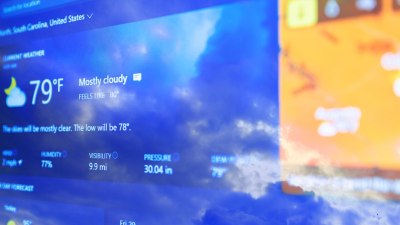How Temperature Swings Create Retail Therapy Opportunities
Explore how temperature changes impact consumer behavior and create retail therapy chances.

Image by gpointstudio on Freepik
In today's fast-paced world, retail therapy has become a popular coping mechanism for many individuals looking to alleviate stress and anxiety. One intriguing factor that significantly influences the urge for retail therapy is temperature swings. As seasons change and temperatures fluctuate, people's moods and behaviors tend to shift, creating unique opportunities for retailers to attract consumers. This article delves into how temperature swings impact shopping habits and how businesses can capitalize on these shifts.
Understanding Retail Therapy
Retail therapy refers to the practice of shopping to improve one’s mood or alleviate negative feelings. It often involves purchasing items that may not be necessary but provide a temporary sense of happiness or satisfaction. Psychological studies have shown that shopping releases dopamine, a neurotransmitter that plays a role in feelings of pleasure and reward. This is particularly relevant when individuals experience stress or emotional distress, making retail therapy an appealing option.
The Impact of Temperature on Mood
Temperature has a profound effect on human psychology. For example, during warmer months, people tend to exhibit more positive emotions, which can influence their shopping behavior. Conversely, colder months often correlate with increased feelings of sadness or lethargy, particularly during long winters when sunlight is scarce. These emotional fluctuations cause individuals to seek comfort, sometimes through retail therapy.
Seasonal Trends and Retail Responses
As the seasons change, so do consumer preferences and shopping behaviors. Retailers often adapt their strategies to align with the sentiments of their customers. For instance, during the spring, when temperatures start to rise, consumers may be more inclined to shop for new clothing items, outdoor gear, or home decor to refresh their living spaces. Retailers can capitalize on this trend by running promotions geared towards spring cleaning or outdoor activities. Similarly, as summer approaches, the demand for products like swimsuits and vacation accessories spikes, creating further retail opportunities.
In contrast, when summer transitions to fall, the cooler temperatures signal the arrival of back-to-school shopping, Halloween merchandise, and cozy home products. Retailers can leverage this shift by launching targeted marketing campaigns to entice consumers looking for seasonal items. The same pattern continues into winter, where holiday shopping becomes the main focus. Retail therapy opportunities abound during this time as individuals seek comfort and joy amidst the hustle and bustle of the holiday season.
Temperature Swings and Impulse Buying
Another significant aspect of temperature swings is their potential to drive impulse buying. When temperatures rise unexpectedly during a typically cooler season, it can prompt consumers to make spontaneous purchases. For instance, a sudden warm spell in late winter may lead people to buy spring clothing or outdoor equipment before they thoroughly consider their budget or needs. Retailers can take advantage of this phenomenon by arranging visually appealing displays and creating time-sensitive promotions that entice consumers to buy impulsively.
Weather-Driven Marketing Strategies
To effectively engage consumers during temperature swings, retailers must employ targeted marketing strategies. Utilizing weather data to inform marketing efforts can lead to increased sales. For example, sending personalized promotions via email or app notifications at the start of a warm spell can encourage individuals to purchase products suitable for that weather change. Retailers can also create limited-time offers that align with upcoming temperature changes, thereby motivating quick purchases.
Social media platforms provide an excellent opportunity for retailers to showcase their products relevant to current weather conditions. High-quality images of seasonal products can captivate consumers' attention, particularly during temperature swings, when emotions are heightened. Engaging content that resonates with users can help to cultivate a sense of urgency and desire, driving more traffic to both physical stores and online platforms.
Consumer Behavior During Extreme Weather Events
Extreme weather events often have a significant impact on shopping habits. When faced with snowstorms, hurricanes, or heatwaves, consumers may rush to stock up on essential items, leading to increased sales for retailers offering groceries, household goods, or emergency supplies. Retailers should prepare for sudden spikes in demand during such events, ensuring they have adequate inventory to meet consumer needs.
Moreover, after extreme weather events, there can be a surge in retail therapy as individuals seek comfort and normalcy. People may turn to shopping as a means of regaining control after experiencing stress or hardship. Retailers can cater to this by emphasizing self-care and comfort items such as home goods, cozy clothing, or luxury items that provide a sense of indulgence. Tailoring marketing messages to reflect themes of resilience and comfort can resonate with consumers in such situations.
Promotional Events Tied to Temperature Changes
Retailers can create promotional events that coincide with temperature changes. For instance, when the temperatures drop, a retailer could initiate a “Winter Warm-Up Sale,” offering discounts on winter apparel, blankets, and hot beverages. Such promotions can draw in customers seeking to prepare for colder weather while also tapping into the emotional connection associated with comfort during the winter months.
Additionally, hosting in-store events tied to seasonal changes can increase foot traffic and generate excitement. For example, a summer patio party could introduce customers to outdoor living products, while a winter wellness event could promote skincare and cozy home items. These events create a fun and engaging atmosphere, encouraging shoppers to explore products they may not have considered previously.
The Role of Online Retailers in Temperature Swings
With the rise of online shopping, retailers must adapt to how temperature swings impact consumer behavior in digital environments. Online retailers can utilize data analytics to track weather patterns and adjust their marketing strategies accordingly. Personalized recommendations based on current weather conditions can enhance user experience, encouraging shoppers to make purchases that align with their immediate needs.
Furthermore, online retailers can create engaging content that educates consumers about the best products for varying temperatures. This could include blog posts, videos, or social media content highlighting seasonal fashion trends or home improvement tips. By establishing themselves as authorities in their respective niches, online retailers can build consumer trust and encourage repeat purchases.
Emotional Connections and Brand Loyalty
Building emotional connections with customers during temperature swings can foster brand loyalty. Retailers can achieve this by sharing relatable stories through their marketing campaigns that acknowledge the challenges and joys associated with changing seasons. For instance, a winter campaign that emphasizes the warmth of home and family can resonate deeply with consumers, prompting them to connect with the brand on a personal level.
Furthermore, offering loyalty programs that reward consumers for shopping during seasonally relevant promotions can encourage repeat business. Shoppers who feel recognized and appreciated are more likely to return to a brand, especially during times of emotional need, such as seasonal changes. Personalizing the shopping experience, whether online or in-store, enhances this connection, making consumers feel valued and understood.
Temperature swings play a vital role in shaping consumer behavior and creating opportunities for retail therapy. By understanding how these fluctuations impact emotions and shopping habits, retailers can craft effective marketing strategies that resonate with consumers’ needs. Employing targeted promotions, engaging content, and building emotional connections can transform seasonal challenges into retail opportunities. Ultimately, retailers who recognize and respond to the influence of temperature on shopping behavior will not only enhance their sales but also foster loyal connections with their customers.











